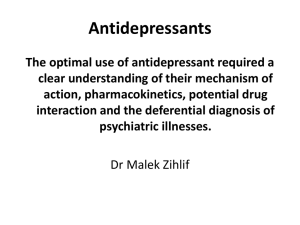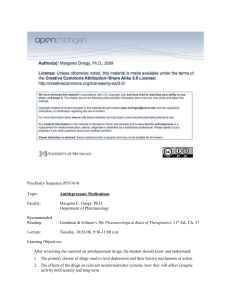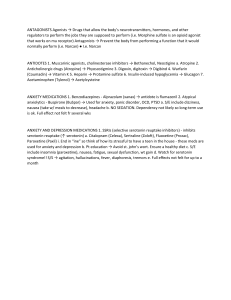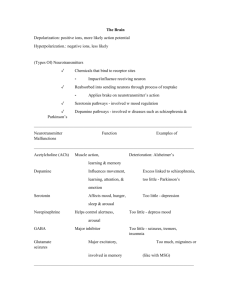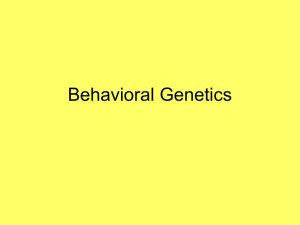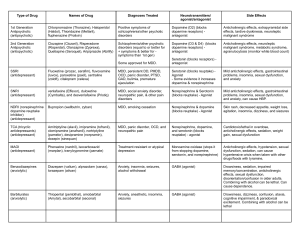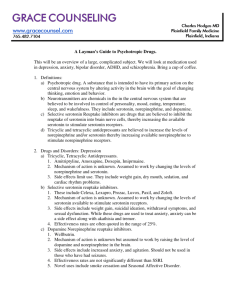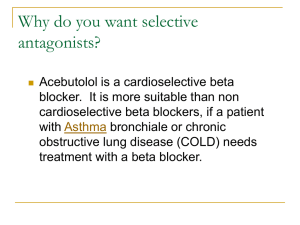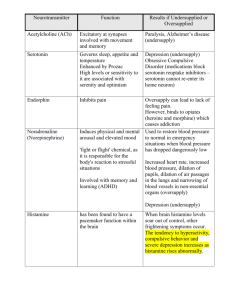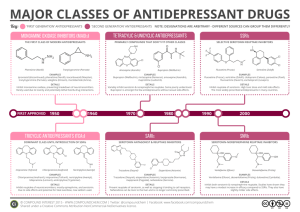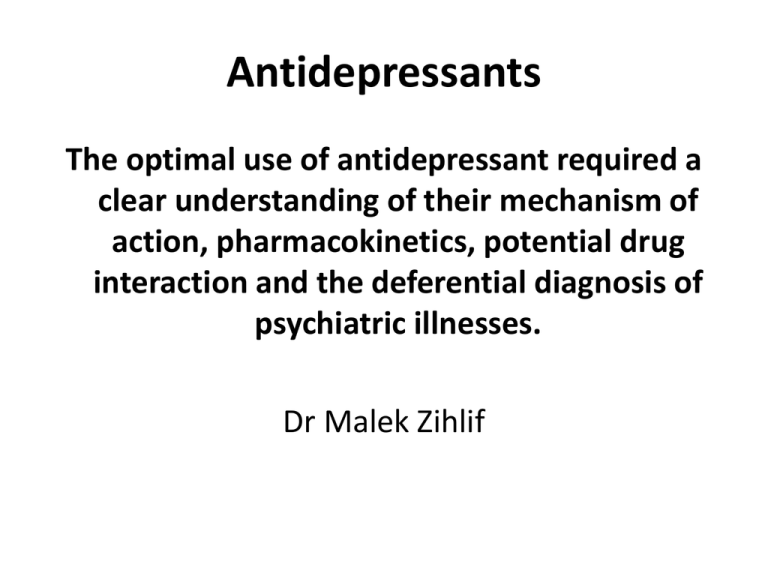
Antidepressants
The optimal use of antidepressant required a
clear understanding of their mechanism of
action, pharmacokinetics, potential drug
interaction and the deferential diagnosis of
psychiatric illnesses.
Dr Malek Zihlif
Depression
A World Health Organization (WHO) Prediction
• Depression is currently the FOURTH most significant cause of
suffering and disability worldwide
• and, sadly, It will be the SECOND most debilitating human
condition by the year 2020.
Chemical “Jobs”
Dopamine
• Attention
• Pleasure
• Emotions
• Reward
• Motivation
• Movement
Norepinephrine
• alertness
• Observance
• Daydreaming
• Heart/BP rates
• Stress
Serotonin
• Regulates mood
• sleep
• emesis
• sexuality
• Appetite
• impulsiveness/
aggression
Depression
• Symptoms
– Cognitive
• Thoughts of hopelessness, poor confidence, negative
thoughts.
– Emotional
Feeling sad, unable to feel pleasure, irritability
– Psychomotor/Physical
• Decreased libido, energy
• Sleep changes (70% less, 30% more)
• Appetite changes (70 % less, 30 % more)
Depression: Treatment
• Antidepressant Medications
– Selective serotonin reuptake inhibitor (SSRI’s) are first
line of treatment
• Psychotherapy
– Usually individual psychotherapy
– Cognitive behavioral therapy has most evidence for
efficacy of treatment.
• Sometimes exercise or body awareness has been found to
helpful
MONOAMINE OXIDASE (MAO) AND
DEPRESSION
• MAO catalyze deamination of intracellular monoamines
– MAO-A oxidizes epinephrine, norepinephrine,
serotonin
– MAO-B oxidizes phenylethylamine
– Both oxidize dopamine nonpreferentially
• MAO transporters reuptake extracellular monoamine
Monoamine oxidase inhibitors
(MAOI)
• Inhibition of intra-neuronal degradation of serotonin and
norepinephrine causes an increase in extracellular amine
levels.
• Phenelzine is a none selective
• Selegiline is a selective for MAO-B)
• Side effects:
Blood pressure problems, Dietary requirements, Weight gain,
Insomnia, Edema.
Tricycle antidepressant (Amitriptyline)
• TCAs inhibit serotonin, norepinephrine,
transporters, slowing reuptake.
and
dopamine
• with a resultant increase in activity.
• Muscarinic acetylcholine receptors, alpha-adrenoceptors, and
certain histamine (H1) receptors are blocked.
Side effects:
(1) drug-induced Sedation
(2) Orthostatic hypotension
(2) Cardiac effects
(3) Anticholinergeric effects dry mouth, constipation,blurred vision,
urinary retention
SSRIs (Serotonin-specific reuptake inhibitors)
inhibits the reuptake of serotonin without seriously effecting the
reuptake of dopamine & norepinephrine.
Most common side effects include GI upset, sexual dysfunction
(30%+!), anxiety, restlessness, nervousness, insomnia, fatigue
or sedation, dizziness
Can develop a discontinuation syndrome with agitation,
nausea, disequilibrium and dysphoria
SSRI/SNRI Discontinuation Syndrome in Adults
F.I.N.I.S.H.
• Flu-like symptoms: fatigue, muscle aches, headache, diarrhea
•
•
•
•
Insomnia: vivid or disturbing dreams
Nausea
Imbalance: gait instability, dizziness, lightheadedness, vertigo
Sensory disturbance: paresthesia, “electric shock” sensation,
visual disturbance
• Hyperarousal: anxiety, agitation
• Onset: 24-72 hours + Resolution: 1-14 days
• Incidence: ~ 20 - 40 % (who have been treated at least 6 weeks)
Why there are many of them
Paroxetine: Sedating properties (dose at night) offers good initial
relief from anxiety and insomnia
Significant CYP2D6 inhibition
Sertraline: Increased number of GI adverse drug reactions
Fluoxetine Secondary to long half life, less Discontinuation
Syndrome
Significant P450 interactions so this may not be a good choice in pts
already on a number of meds
Initial activation may increase anxiety and insomnia
More likely to induce mania than some of the other SSRIs
Serotonin/Norepinephrine reuptake
inhibitors (SNRIs)
• Slightly greater efficacy than SSRIs
• Slightly fewer adverse effects than SSRIs
– Venlafaxine
– Duloxetine
1. Can cause a 10-15 mmHG dose dependent increase in diastolic
BP.
2. May cause significant nausea,
3. Can cause a bad discontinuation syndrome, and taper
recommended after 2 weeks of administration
Buproprion
Good for use as an augmenting agent
Mechanism of action likely reuptake inhibition of dopamine and
norepinephrine
No weight gain, sexual side effects, sedation or cardiac
interactions
Low induction of mania
Does not treat anxiety unlike many other antidepressants and
can actually cause anxiety, agitation and insomnia
• Following the initiation of the antideppresant
dryg treatment there is generally a
therapuetic lag lasting for 3-4 weeks.
• 8 weeks trial, then you allow to switch to
another antidepressant.
• Partial response then add one another drug
from different class.
• if the initial treatment was successful then 612 maintenance periods.
• If the patient has experience two episodes of
major depression, then it is advisable to give
an anti depressant life long.

